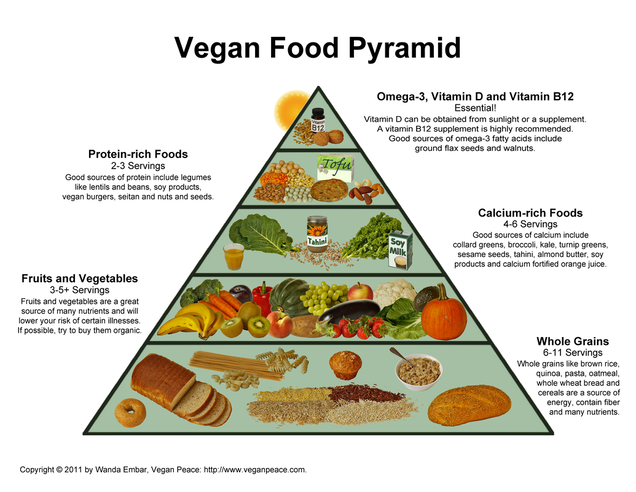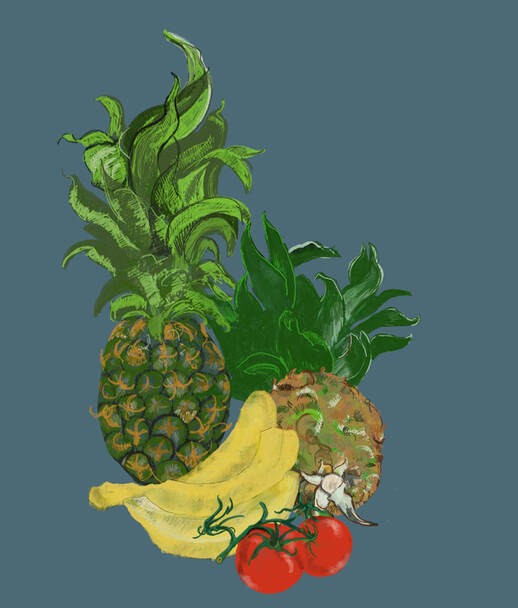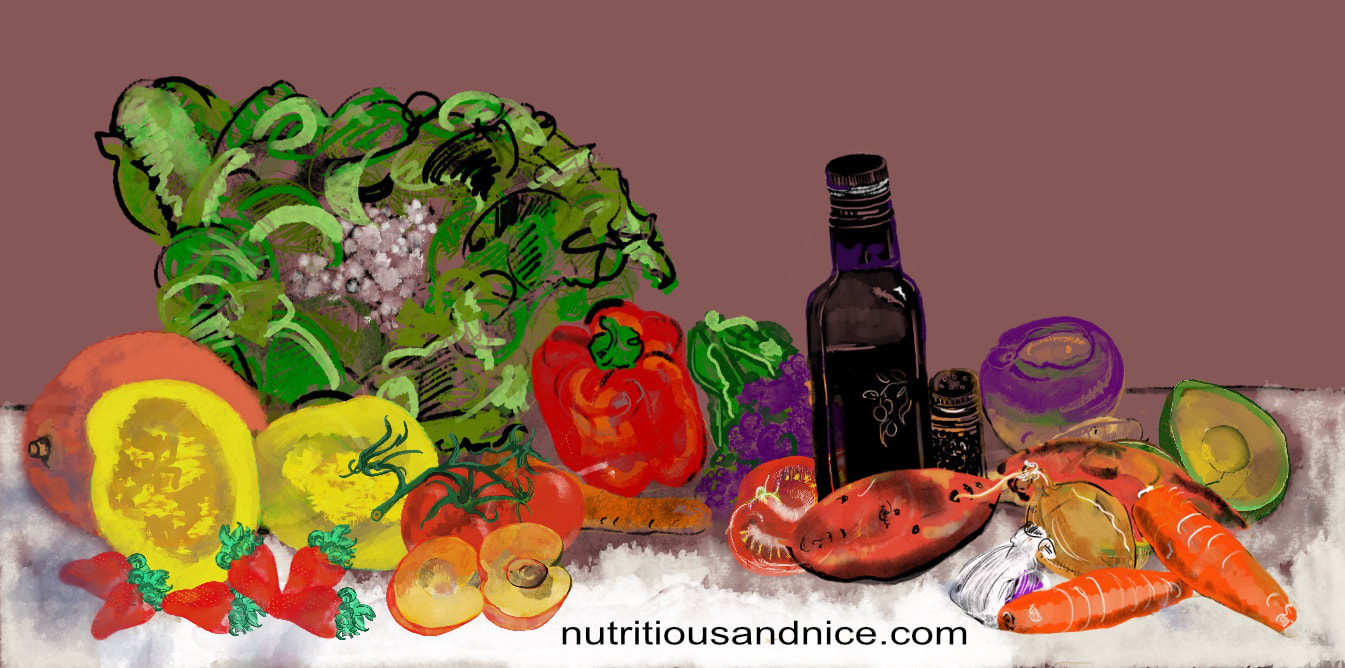NUTRITIOUSANDNICE.COM
A Balanced Diet

It is important for optimum health that a balance in the Essential nutrients is obtained. This includes the intake of vitamins, minerals, and phytonutrients, which act as; cofactors, contribute to enzymes, and a play a role in variety of metabolic functions.
Sufficient calories are required each day to support metabolisms within the body. The amount of calories required are influenced by a number of factors, for example; age, gender, active state, and any particular health issue prevalent at the time. However the amount of calories is only one aspect, the nutrient quality of the food is of greater importance.
We live in an age where in developed countries food is easy obtained. Foods high in fat and sugar are in many ways found to be more satisfying. Our hunger is stimulated not only by our metabolic needs but the sights, smells, and our emotional state. This has often resulted in a rise in obesity levels. Latest figures by the World Health Organisation has estimated that worldwide obesity levels have tripled since 1975. Alongside this there has been an increase in eating disorders, particularly, but not exclusively, affecting teenagers and young adults. There has also been a dramatic rise in food allergies and sensitivities.
While information about the food we eat is more widely available, and the variety of foods eaten has increased, we have perhaps lost touch with the food we consume, and often eat while engaging in other activities. We have become too reliant upon fast food and are no longer aware of the main ingredients within our diet. Choices make are often dictated by economic rather than nutritional needs. Many have become overfed and simultaneously malnourished.
It is important that we have the right balance between the various macronutrients in our diet to ensure that we are getting all the nutrients required to support our daily demands. If we were to think of a typical meal, the major constitute would be Carbohydrates, around 60%, the next highest would be Protein around 20%, followed by fats 15% and fibre the remaining 5%.
While information about the food we eat is more widely available, and the variety of foods eaten has increased, we have perhaps lost touch with the food we consume, and often eat while engaging in other activities. We have become too reliant upon fast food and are no longer aware of the main ingredients within our diet. Choices make are often dictated by economic rather than nutritional needs. Many have become overfed and simultaneously malnourished.
It is important that we have the right balance between the various macronutrients in our diet to ensure that we are getting all the nutrients required to support our daily demands. If we were to think of a typical meal, the major constitute would be Carbohydrates, around 60%, the next highest would be Protein around 20%, followed by fats 15% and fibre the remaining 5%.
Water

Water makes up 60% of our bodies. The majority of which, 40%, is intracellular, 15% extracellular and 5% in plasma. Water serves as a solvent for minerals, vitamins, amino acids, glucose, and other smaller molecules. It acts as a lubricant and helps cushion around joints, eyes, spinal cord, and in pregnancy within the amniotic sac where the foetus develops. It regulates body temperature and maintains blood volume.
Water drunk 20 minutes prior to a meal aids digestion. The body sends out various signals when it is dehydrated, for example histamine is more active when the body is dehydrated. Chronic dehydration will show up as pain. Often people will confuse these signals as that of being hungry.
Dehydration reduces blood vessel capillaries, and more cholesterol is produced. It sticks to gaps in the cell membrane to make the wall impervious to the passage of water. When the body is dehydrated it triggers the stress response; endorphins raise the pain threshold, cortisol initiates the breakdown of stored energy, and fats are broken down into fatty acids. Prolactin makes sure that the lactating mother will continue to produce milk. Vasopressin, which helps to maintain osmotic pressure within the blood will cause the constriction of capillaries. Kinins produced by salivary glands will stimulate the production of more saliva.
Water should be consumed 6 - 8 glasses (minimum) daily. Slow sips instead of gulps. Drinking in excess (within limits) is better than too little as it is easier for the body to excrete water rather than conserve. Drinking warm water is a good way of increasing water intake in colder seasons. Lemon juice and fresh herbs such as Ginger and Rosemary help improve digestion and circulation. It is good to start the day with a glass of warm water and the juice of half a lemon.

A Vegan Diet: Benefits include: less obesity, reduced risk of food-borne diseases, higher nutrient density, better balance of protein, carbohydrates, and fat. A vegan diet tends to be lower in saturated fat, lower in cholesterol, and lower in trans-fatty acids. Have higher levels of vitamin C, E, and provitamin A, folate, fibre, magnesium and phytonutrients. There is a reduced risk of heart disease, lower blood pressure, higher levels of antioxidants. Reduced risk of cancer and diabetes.
Things that need to be considered. Make sure that one includes Vitamin B12 in the diet (10 mcg. daily), Be aware of Omega 3 requirements. Foods rich in Zinc and Iron should also be eaten. It is important to make sure that Vitamin D (5-15 mcg daily) levels are adequate. Calcium should be based on unrefined food, which includes; broccoli, kale, collards, and Chinese cabbage.
Raw food Diet: Belief that raw foods preserve the integrity of its constituents. Vegetables, fruits, nuts, seeds and sprouted grains and beans all eaten in their raw state. The Diet provides many phytonutrients, vitamins and minerals, with an optimal ratio of sodium to potassium. It is a very alkaline diet which is also beneficial towards general health. It offers similar benefits as a vegan diet.
Things to consider however are: It is challenging to follow as there is a need to consume large quantities of fruit and vegetables. Need to make sure that Omega 3 foods are consumed. Also that Vitamin D and B12 levels are also maintained.
[ i ] Parallax section below. Click on the section below to upload image. Don't worry if it looks weird in the Weebly editor. It'll look normal on your published site.
To edit or delete your image, press the "toggle" button below. Then, hover over your image until a popup appears with the "edit" and "delete" options. Since these are parallax sections, you may need to scroll a bit up or down to be able to click on the "edit image" popup.

